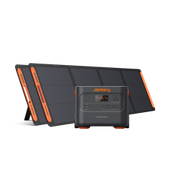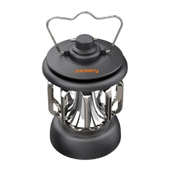As the popularity of solar panels increases, they have become the ideal power source for camping and off-grid living. Solar panels are available for all campers, including portable panels for campers and hikers and mountable panels for RVs.
Experienced campers know you can go off the grid without giving up your electronics if you bring a high-quality solar panel designed for camping and the outdoors. With camping solar panels, you can power anything from your phone to an electric refrigerator with nothing more than a sunny day and a clear view of the sky.
This comprehensive guide to camping solar panels covers everything you need to know, including what camping solar panels are, their varieties, how they function, and how to choose the best camping solar panels. We recommend Jackery Solar Panels with variable power output to meet your needs. It combines solar panels with our Portable Power Stations to maximize solar energy, but you can also connect Jackery Solar Panels to power stations from other manufacturers for camping use. You can find the solar panels recharging time here.
|
Solar Panels |
Product Image |
Peak Power |
Efficiency |
Dimensions |
Weight |
|
 |
200W |
24.3% |
21,2 x 24,2 x 1,6 in (540 x 615 x 40 mm) |
17.5±0.5lbs (8.0±0.3Kg) |
|
|
 |
100W |
24.3% |
24 x 21 x 1.4 in (610 x 535 x 35 mm) |
10.33 lbs (4.69 kg) |
What Is A Camping Solar Panel?
Solar panels for camping are instruments that convert sunlight into electricity. They have a variety of applications, including powering devices in remote locations or sites. In addition, they utilize pure and renewable solar energy, making them an eco-friendly camping option. Besides, they are economical, silent, and maintenance-free.
Whether you're an experienced camper or a beginner, you're likely aware that portable solar panels are now necessary for most camping excursions. It is essential if you are traveling with your family for an extended period or to a remote location where supplies are scarce.
Solar panels are tranquil and power your devices without disturbing your day. Solar energy is a renewable resource readily accessed with minimal environmental impact. Regardless of where you travel, your solar panels will function as long as there is sunlight.
What Are The Types of Camping Solar Panels?
Solar panels are trendy, with various options saturating hardware stores and online marketplaces. Choosing which camping solar panels to purchase can take time and effort, with many possibilities.
According to the various solar cell technologies and applications, there are two classifications for camping solar panels.
Camping Solar Panels by Solar Cell
Polycrystalline and monocrystalline cells are currently the most common varieties of cells used in camping solar panels. A third variety, thin film, is occasionally encountered. Still, it is significantly less common than the other two because it requires roughly double the surface area to produce the same energy and is less durable.
- Monocrystalline Solar Panels comprise a single silicon crystal grown into a block and then sliced into wafers like polycrystalline cells. Because the cell is a single crystal, electrons can flow more readily, and the panel's efficiency is significantly increased.
In addition, monocrystalline cells have a longer lifespan and perform better at higher temperatures than polycrystalline cells. All Jackery Solar Panels are constructed from monocrystalline solar cells, which are more robust, potent, and long-lasting.
- Polycrystalline Solar Panelscomprise numerous fragments of silicon crystal fused to form a block or ingot. This block is then sliced into wafers with a thickness between 200 and 350 micrometers, constituting the solar cell's basis.
- Thin-Film Solar Panelsare second-generation cells that are incredibly light and flexible. Multiple thin layers of photovoltaic (PV) materials comprise them. Although thin-film solar panels are less expensive than monocrystalline and polycrystalline silicon panels, they are significantly less efficient and have a smaller power output.
|
Types |
Efficiency |
Power Output |
Lifespan |
|
Monocrystalline |
High |
High |
Long |
|
Polycrystalline |
Middle |
Middle |
Medium |
|
Thin-Film |
Low |
Low |
Short |
Camping Solar Panels by Usages
A compact solar panel should function adequately under normal weather conditions if you only use it to power smartphones and lights. An enormous solar array is recommended when planning extended excursions, family vacations, or using solar power for off-grid RV and van applications. There are three primary varieties of camping solar panels, each with distinct applications.
- Portable Solar Panelsare ideal for camping and trekking. No installation is required to be permanent. Portable solar panels can be assembled and stored in minutes, occupying little space in your trunk.
- Rigid Solar Panelson your RV, van, or off-grid cabin is possible. Even while traveling, the permanent installation allows you to harness the sun's energy.
- Flexible Solar Panelsare also designed for permanent installation but can be temporarily suspended from their eyelets. Instead of rigid panels, flexible solar panels can conform to curved and irregular surfaces. The primary disadvantage of flexible solar panels is their reduced rated power output compared to wooden or portable panels.
|
Types |
Pros |
Cons |
|
Portable Solar Panels |
Easy to carry
High-quality solar cell Overcharge protection Low maintenance |
Need space to put |
|
Rigid Solar Panels |
Durability Maximize solar gain Weather-resistance Higher power output |
Need professional installation Heavy Pricey |
|
Flexible Solar Panels |
Flexibility Mounted in more configurations and locations Lighter |
Pricey Short lifespan |
Jackery is renowned for its portable solar panels with higher conversion efficiencies, which can be used to power camping electronics using solar energy. Solar panels from Jackery are adaptable to various functions and activities. Jackery Solar Panels are compact, foldable, and waterproof.
How Do Camping Solar Panels Work?
When you think of solar panels, you may envision the enormous panels that rest atop homes, which would not be suitable for camping. Numerous solar panels are now lighter, more portable, and rugged enough to withstand a lengthy road journey.
Although the technology is more refined, camping solar panels function similarly to other solar panels. They absorb energy from the sun, transfer it to a solar inverter, and then produce electricity that can be used to power your lights, water heater, mobile phone, and camera.
How Do Jackery Solar Panels Work?
People used to disregard camping solar panels because they didn't believe they could do the job, but nothing could be further from the truth. Camping solar panels must maintain a delicate balance between portability and weather resistance.
With monocrystalline solar cells, Jackery Solar Panels have a higher power conversion efficiency, allowing for greater solar energy utilization. Jackery Solar Panels typically convert sunlight into electricity. You can pair solar panels with the Jackery Portable Power Station to store and use electricity through the solar connector and cables. Alternatively, you can connect Jackery Solar Panels to other third-party power stations.

Jackery Solar Panels are ideal for camping due to their portability, ease of use, and resistance to the elements. Jackery Solar Panels and Portable Power Stations can be combined to power camping appliances, such as a camping lantern, a phone, a coffee maker, etc.
Jackery Solar Panels for Camping
Setting up a solar panel for camping is much simpler than you might believe. Whether this is your first introduction to solar energy or you need help choosing the appropriate kit for your camping trip, Jackery Solar Panels has you covered.
However, you must first estimate your energy consumption to ensure e solar panel you purchase meets your requirements. Consider all the appliances and devices you intend to use on your excursion. Typically, a campsite requires 1.5kW to 3kW of electrical power to generate energy. From there, you can estimate your watt-hour energy consumption with simple calculations.
The energy consumption formula is as below:
Watt-Hour = Amps x Volts x Hours
For instance, if you have a 0.9A refrigerator on 12V DC that operates 24 hours a day while camping or traveling, the power consumption is 0.9A*12V*24H, which equals 259.2Wh. The camping power consumption is shown in the table below.
|
Camping Appliances |
Minimum Wattage |
Maximum Wattage |
|
Radio |
50W |
200W |
|
TV |
150W |
400W |
|
Laptop |
25W |
200W |
|
Refrigerator |
400W |
1200W |
|
Stove |
900W |
2500W |
|
Microwave |
1000W |
1500W |
|
Hair Dryer |
600W |
1000W |
Jackery SolarSaga 200W Solar Panel: Best for Family Camping
Product Specs
- Power Rating: 200W
- Conversion Efficiency: 24.3%
- Materials: Monocrystalline silicon solar cells
- Waterproof: IP68
- Solar Power: Peak Power: 200W±5%, Peak Voltage: 20V±5%, Peak Current: 10A±5%
- Dimensions: Folded: 24.21 x 21.73 x 1.57 in (615 x 552 x 40 mm), Unfolded: 92.13 x 21.73 x 0.98 in (2340 x 552 x 25 mm), Weight: 13.67 lbs ± 0.66 lbs (6.2 kg±0.3 kg)
The Jackery SolarSaga 200W Solar Panels have exceptional comfort and performance. They are high-quality and primarily practical camping solar panels. With the adjustable set-up angles and magnetic pads, the foldable module can be set up flexibly and folded up rapidly. They can be assembled and disassembled in seconds. There is a bag for transporting the solar panel and the necessary cables when camping and hiking.

*Learn more details from our product page.
|
Explorers |
No. of Panels & Solar Charging Time |
Capacity |
Camping Appliances |
|
Explorer 600 Plus |
2*200W: 3.5H |
632Wh |
Radio(50-200W): 2.6-10.7H TV(150-400W): 1.3-3.5H Laptop(25-200W): 2.6-21.4H Fridge(400W): 1.3H Microwave(1000-1500W): 1.6-2.4H |
|
Explorer 1000 v2 |
2*200W: 3.8H |
1070Wh |
Radio(50-200W): 4.5-18.1H TV(150-400W): 2.2-6.0H Laptop(25-200W): 4.5-36.3H Fridge(400W): 2.2H Microwave(1000W): 54 min |
|
Explorer 1000 Plus |
6*200W: 1.8H |
1264Wh |
Radio(50-200W): 5.3-21.4H TV(150-400W): 2.6-7.1H Laptop(25-200W): 5.3-42.9H Fridge(400W): 2.6H Microwave(1000W): 1.0H |
*Learn more details from our product page.
Jackery SolarSaga 100W Solar Panel: Best for Weekend Camping
Product Specs
- Power Rating: 100W
- Conversion Efficiency: 24.3%
- Materials: Monocrystalline silicon solar cells
- Waterproof: IP68
- Solar Power: Peak Power: 100W±5W, Peak Voltage: 20.0V±5%, Peak Current: 5.0A±5%
- Dimensions: Folded: 24.0 x 21.7 x 1.4 in (610 x 552 x 35 mm), Unfolded: 48.03 x 21.73 x 0.79 inches (1220 x 552 x 20 mm), Weight: 7.94 lbs ± 0.66 lbs (3.6 kg ± 0.3 kg)
The Jackery SolarSaga 100W solar panel is a cost-effective, highly functional, and extremely portable 100W solar panel ideal for solar camping. Notably, the higher 24.3% power conversion efficiency enables it to convert sunlight into electricity regardless of the weather conditions.

|
Explorers |
No. of Panels & Solar Charging Time |
Capacity |
Camping Appliances |
|
Explorer 600 Plus |
2*100W: 4.3H |
632Wh |
Radio(50-200W): 2.6-10.7H TV(150-400W): 1.3-3.5H Laptop(25-200W): 2.6-21.4H Fridge(400W): 1.3H Microwave(1000-1500W): 1.6-2.4H |
|
Explorer 1000 v2 |
6*100W: 3H |
1070Wh |
Radio(50-200W): 4.5-18.1H TV(150-400W): 2.2-6.0H Laptop(25-200W): 4.5-36.3H Fridge(400W): 2.2H Microwave(1000W): 54 min |
|
Explorer 1000 Plus |
6*100W: 3H |
1264Wh |
Radio(50-200W): 5.3-21.4H TV(150-400W): 2.6-7.1H Laptop(25-200W): 5.3-42.9H Fridge(400W): 2.6H Microwave(1000W): 1.0H |
*Learn more details from our product page.
Jackery SolarSaga 40W Mini Solar Panel: Best for Short Camping
Product Specs
- Power Rating: 40W
- Conversion Efficiency: 23%
- Materials: Monocrystalline silicon solar cells
- Waterproof: IP68
- Solar Power: Peak Power: 40W±5%, Peak Voltage: 25V±5%, Peak Current: 2.07A±5%
- Dimensions: Folded: 9.9×11.8×1.2 in (252×300×30mm), Unfolded: 40.1×11.8×0.7 in (1020×300×18.5mm), Weight: 2.6±0.5 lbs (1.2kg±0.2kg)
For solo camping or hiking trips, you can consider investing in the ultra-lightweight Jackery SolarSaga 40W Solar Panels and a compatible power station. The solar panels are certified IP68 waterproof and dust-proof against extreme weather conditions. They also feature output ports so you can directly charge smaller devices such as a camera, drone, or a phone.

|
Explorers |
No. of Panels & Solar Charging Time |
Capacity |
Camping Appliances |
|
Explorer 240 v2 |
1*40W: 5.5H |
256Wh |
Radio(50W): 4.3H TV(150W): 1.4H Phone(25W): 8.7H Lights(10W): 21.7H |
|
Explorer 300 Plus |
1*40W: 11H |
288Wh |
Radio(50W): 4.8H TV(150W): 1.6H Phone(25W): 9.7H Lights(10W): 24.4H |
|
Explorer 600 Plus |
2*40W: 11H |
632Wh |
Radio(50-200W): 2.6-10.7H TV(150-400W): 1.3-3.5H Laptop(25-200W): 2.6-21.4H
Microwave(1000-1500W): 1.6-2.4H |
*Learn more details from our product page.
How to Choose The Camping Solar Panels?
Consider your needs and the duration of your camping trip before deciding on the best camping solar panels. When purchasing solar panels for camping, you should consider several aspects.
- Power Output
Although different solar panels have varied power ratings, size generally correlates with output regarding solar energy production. Under ideal conditions of sunshine and temperature, a solar panel's wattage is the unit of measurement for its power production. You can choose the right size of solar panels via power output for your camping.
While most campers have ample space to set up a solar panel system, the same cannot always be said for the vehicle used to get there. Consider a smaller solar panel if your space is limited, the weather is predictable, and your energy requirements are low.
- Camping Duration
One night, one month, or twelve months? If you only camp occasionally for one night, a compact solar panel and portable power station will suffice. Frequent campers or full-time RVers will likely require more power output and storage to provide electricity for a broader range of appliances to power life's necessities.
Camping Solar Panels FAQs
These are the most frequently posed questions about solar panels for camping:
- What size of solar generator do I need for my camping?
Typically, a campsite requires 1.5kW to 3kW of electrical power to generate energy. Solar generators are an excellent alternative to gasoline-powered generators due to their low operating costs and absence of emissions.
Jackery Solar Panels and Portable Power Stations collaborate to maximize the use of solar energy via Jackery Solar Generators. With capacities ranging from 99Wh to 5040Wh, you can choose a battery according to your requirements. However, you must first calculate and estimate your power consumption and then calculate the working hours using Jackery Solar Generators:
Working Time = Power Station Capacity*0.85 / Your Device's Operating Wattage
For instance, charging a 500W coffee maker with Solar Generator 2000 Plus (2042.8Wh capacity) will take 3.4 hours (2160Wh*0.85/500W).

- What size of solar panel is best for camping?
The optimal size of solar panels for camping depends on what you intend to power. You'll only need a single, compact solar panel to charge a smartphone. A triple or quadruple panel configuration will work better if you charge multiple appliances or devices.
The solar panel power output determines the size of the device it can power. For instance, if you have a refrigerator that requires at least 200Wh to charge, your power system should exceed 200Wh, and you should select 200W solar panels along with a power station. You can connect several Jackery Solar Panels with series or parallel.
- Are camping solar panels worth it?
Portable solar panels are advantageous for all outdoor activities, including trekking and camping. In addition, most of these panels are adaptable, water-resistant, and low-maintenance. Regarding disadvantages, portable solar panels are a tad more costly. As a camping companion, portable solar panels are advantageous—specifically Jackery Solar Panels, which have a higher conversion efficiency.
Final Thoughts
Portable solar panels are game-changers for campers, who are all too familiar with the difficulty of relying on limited and distant power sources. Whether camping, hiking, or investigating areas with limited outlets, portable solar panels can keep your devices and appliances powered by converting solar energy.
Now that you understand how to choose the right camping solar panels, it's time to go camping. Choose Jackery SolarSaga 200W for a delightful family camping trip, SolarSaga 100W for a weekend, or SolarSaga 40W for a brief camping trip. Bonus tip: if you combine Jackery Solar Panels and Jackery Portable Power Stations, you can fully use solar energy within one minute.




















































































































Leave a comment